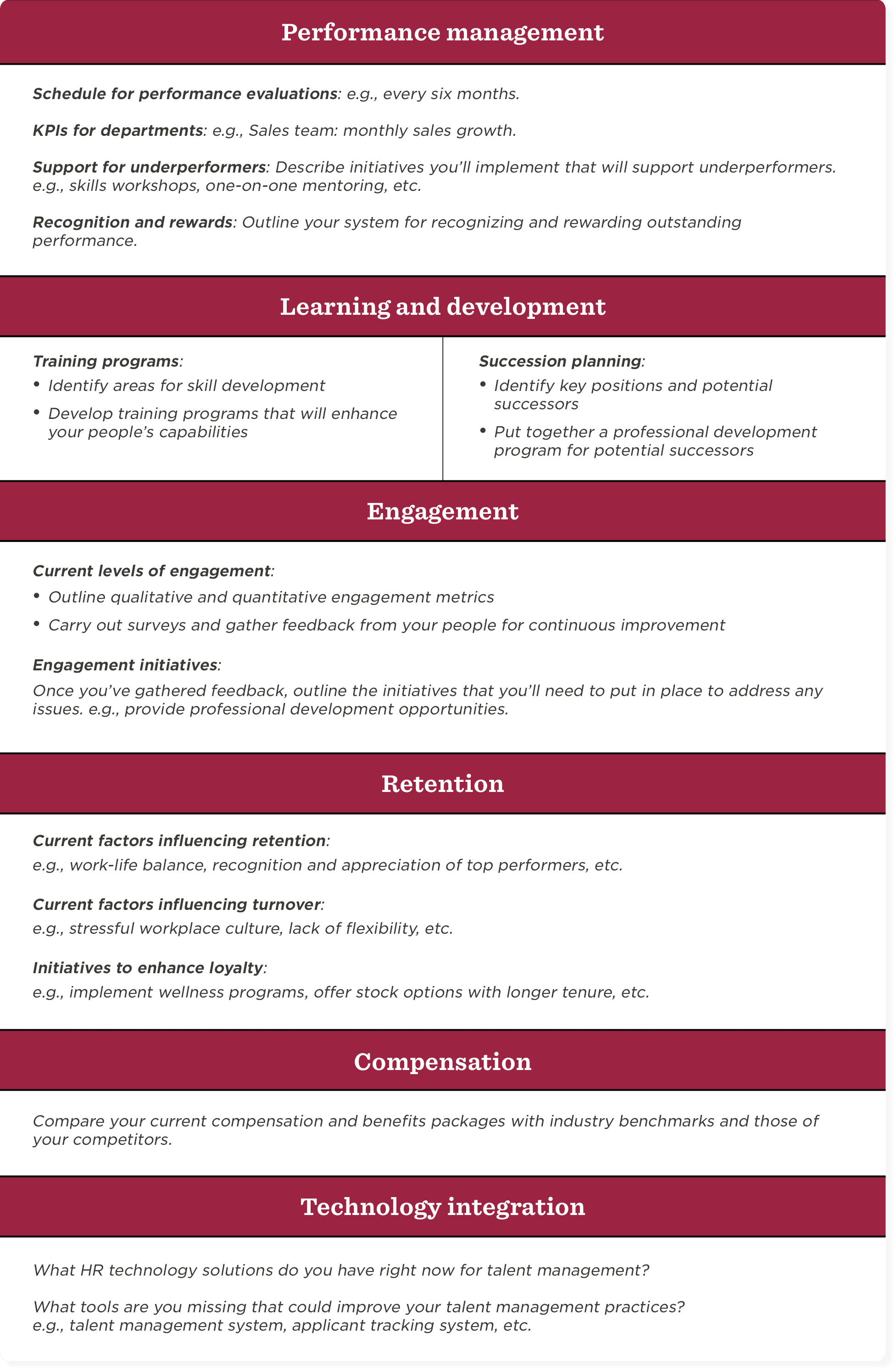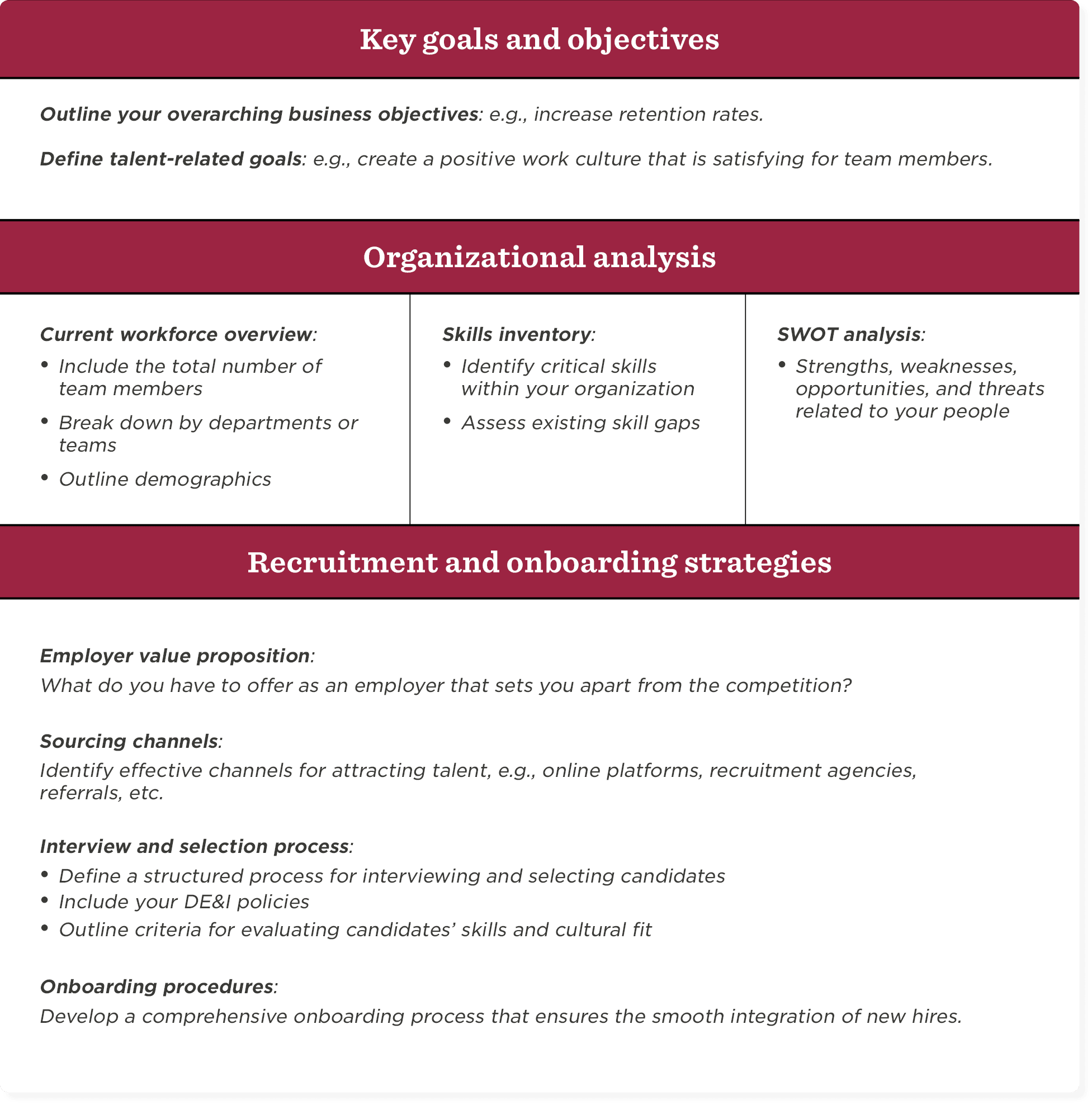How do you bring out the best in your people?
This is a question that lies at the heart of HR. The answer? An effective talent management strategy.
Each new hire brings unique talents and abilities that can contribute to your organization’s success. However, hiring a new team member is just the first step; retaining that professional requires a thoughtful and strategic approach. From the first steps of preboarding, HR’s job is to bring out the best in the company’s people at every stage of the employee lifecycle.
HR leaders today need to create a talent management strategy and make it an integral part of what they do. With an effective talent management strategy, you have a clear plan and process that unlocks your people’s potential and helps your organization succeed.
But how do you create an effective talent management strategy? In this guide, you’ll discover everything you need to know about strategic talent management, along with a template example and a blank printable version that’ll help you develop your very own strategy.

What is a talent management strategy?
A talent management strategy outlines how an organization intends to attract, develop, and retain top talent—aligning people’s abilities with company objectives.
It addresses challenges at different phases of the talent lifecycle, from revising recruitment practices to increasing retention. A strategy makes it clear what areas of talent management an organization needs to focus on and lays out exactly how it will improve them.
<<Print this talent management strategy template and bring out the best in your people.>>
Why it’s important to have a strategic talent management plan in place
Without a clear strategy, it’s difficult to establish talent management practices that address the needs of your organization.
A plan is essential for effective talent management because of its far-reaching implications on your organization’s success.
A strategic talent management plan can help you:
- Make the hiring process more efficient
- Improve workforce planning
- Nurture high-performing individuals for succession
- Develop your people’s skills
- Increase engagement and satisfaction in the workplace
- Boost retention
Ultimately, it increases business performance. Companies with strong talent management practices have nine percent greater revenue growth than their competition.
In fact, companies that don’t have a strategic talent management plan are at risk of losing Gen-Z and Millennial team members. Flexibility, work-life balance, wellbeing, and development opportunities are just as important to these generations of professionals as compensation.
And they’re willing to leave if their organization does not provide these benefits.
How to develop your strategic talent management plan
Developing your own strategic talent management plan requires a deep understanding of your people and a thorough assessment of your current talent management process.
It’s helpful to break it down by analyzing your talent management practices at different stages of the talent lifecycle:
- Recruitment. Are you attracting the right talent? Do your recruitment processes need to be more efficient? Are there any skill gaps in your organization?
- Onboarding. Is it easy for new hires to become familiar with their roles and feel at home in their new work environment?
- Engagement. Do your people feel committed to their work? What do they need? Do they feel satisfied in the workplace? Are they productive?
- Learning and development. Are you putting initiatives in place that nurture your people? Are there professional development pathways for future leaders?
- Offboarding. Do departing team members leave with a good impression of your company? What’s influencing turnover rates at your organization?
Asking these questions gives you insights into how things are really going. These insights become the building blocks for setting specific goals tailored to your unique challenges.
Once your goals are clear, figure out the talent management metrics that will show whether you’re on the right track. These metrics should reflect your objectives, giving you a tangible way to measure progress and the impact of your talent management efforts.
Armed with goals and metrics, you’re ready to sketch out a practical talent management plan. This plan acts as your strategic guide, laying out the necessary steps to improve talent acquisition, development, and retention. It ensures that your talent management aligns seamlessly with your broader organizational goals, contributing to sustained success.
<<Print this talent management strategy template and bring out the best in your people.>>
Your talent management strategy template
The great news is that you don’t have to build your strategy from scratch. The templates below will walk you through the steps for developing an effective talent management framework for your organization. The first template is an example template we’ve filled in for your reference. The next template is blank, which you can print to adapt it to your own situation.
Example template:

Blank template:

<<Print this talent management strategy template and bring out the best in your people.>>
Talent management strategy examples
Nothing works better than real-life examples showcasing the impact of a robust talent management strategy. Below, you’ll find three companies that significantly improved their business by implementing a strong talent management approach.
Starbucks
Restaurants and cafés have very high turnover rates, with many businesses facing an average annual turnover rate of 79.6 percent over the last ten years.
Yet, despite this, Starbucks has been able to keep its turnover down to 65 percent. What’s its secret?
Starbucks developed a competitive talent management strategy that takes care of its people. The organization provides healthcare, professional development, and income protection—among other benefits—to both part-time and full-time team members.
By investing in a talent management strategy that puts its people first, Starbucks has been able to stand out from the competition.
Hyatt Hotels
World hospitality leader Hyatt has also reaped the rewards of an effective talent management strategy.
Hyatt’s mission statement is to “care for people so they can be their best.” The organization decided to put this philosophy into practice when it came to its talent management strategy.
Hyatt’s senior management team carried out extensive research throughout their branches in 60 countries to gain a deep understanding of their people’s needs.
The insights they gathered from listening to team members triggered an extensive HR transformation that resulted in the following:
- An improved employee experience
- Training and development initiatives for leaders within the organization
- Implementation of HR tech that made processes more efficient
Eventbrite
Where better to look for inspiration than at a company with a reputation for being one of the best places to work?
But Eventbrite didn’t always enjoy that reputation. During its rapid expansion, it struggled with high turnover rates, low productivity levels, and low engagement among its people.
CEO Julia Hartz realized there was a desperate need to transform the organization’s talent management practices. So, Eventbrite developed and implemented a new strategy that encouraged open feedback from team members.
Eventbrite listened to that feedback and provided flexible working arrangements and training and development programs for its people.
It worked.
Eventbrite’s people felt satisfied, productivity increased, and turnover rates plummeted. This contributed to the continued success of the organization and its excellent employer brand.
Best practices for implementing an effective talent management plan
Here are a few best practices to keep in mind to ensure your talent management plan has the greatest impact:
1. Focus on your people
As you can see from the examples above, a good talent management plan focuses on your people. Seeking open feedback from team members and finding out what they need is integral to that.
Once you gather that feedback, it’s important to act upon it—whether that means prioritizing employee experience, providing learning and development opportunities, or putting wellbeing programs in place. DE&I is important in this process since the success of your strategy depends on addressing the needs of everyone within your organization.
2. Encourage growth
One of the main reasons why professionals resign from their jobs is to look for career progression opportunities.
That’s why offering professional development programs significantly impacts your retention rates.
Encouraging growth can also be beneficial when it comes to ensuring continuity within your organization. By giving your people a chance to develop their skills through training initiatives, your recruitment team will find it easier to carry out workforce and succession planning.
They’ll have a vast pool of talent to choose from.
3. Make the most of HR tech
A host of HR tech solutions are available that make strategic talent management easier. Here are a few that can help:
- Talent management system. This specialized software helps you address the different functions of talent management, including recruitment, performance management, learning and development, and compensation.
- Applicant tracking system. An ATS makes your recruitment processes more efficient, helps you attract applicants with the right skills, and increases candidate engagement.
- Employee experience platform. This platform helps you create a positive work environment for your people. It gives you tools for gathering feedback from team members, managing performance, and improving communication and collaboration.
- Employee recognition software. Employee recognition software makes it easy to acknowledge and reward high-performing team members, contributing to a supportive working culture.
Career management software. Team members can use career management software to plan their career paths. It also allows organizations to identify candidates for succession.
4) Communicate clearly
What organizations can overlook is the need for transparency and clear communication when implementing a talent management strategy.
This involves gathering the insights of stakeholders, updating them on progress, and making it clear to your people that you care about them and want to improve. This helps keep stakeholders on board with any changes and fosters loyalty among your team members.
Recommended For Further Reading
5) Improve continuously
Like any good HR strategy, it’s important to regularly assess and adapt your talent management plan to stay on track.
Schedule periodic reviews of your strategy and initiatives and gather feedback from your people. Staying flexible in this way ensures you reap greater and greater rewards from your talent management strategy.
Bring out the best in your people
Talent management refers to an organization’s various practices to attract, develop, and retain valuable professionals. It affects all stages of the talent lifecycle and significantly affects your company’s success.
By using the talent management strategy template above and following the suggested best practices, you’re well-placed to develop a talent management plan that brings out the best in your people and leads your organization to greater heights.


